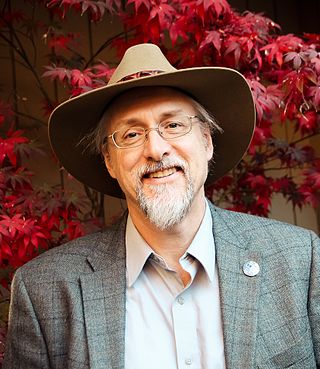Related Research Articles

An asteroid is a minor planet—an object that is neither a true planet nor an identified comet— that orbits within the inner Solar System. They are rocky, metallic, or icy bodies with no atmosphere. The size and shape of asteroids vary significantly, ranging from small rubble piles under a kilometer across and larger than meteoroids, to Ceres, a dwarf planet almost 1000 km in diameter.

Clyde William Tombaugh was an American astronomer. He discovered the ninth planet Pluto in 1930, the first object to be discovered in what would later be identified as the Kuiper belt. At the time of discovery, Pluto was considered a planet, but was reclassified as a dwarf planet in 2006. Tombaugh also discovered many asteroids, and called for the serious scientific research of unidentified flying objects.

Pioneer 10 is a NASA space probe launched in 1972 that completed the first mission to the planet Jupiter. Pioneer 10 became the first of five planetary probes and 11 artificial objects to achieve the escape velocity needed to leave the Solar System. This space exploration project was conducted by the NASA Ames Research Center in California. The space probe was manufactured by TRW Inc.

An impact event is a collision between astronomical objects causing measurable effects. Impact events have been found to regularly occur in planetary systems, though the most frequent involve asteroids, comets or meteoroids and have minimal effect. When large objects impact terrestrial planets such as the Earth, there can be significant physical and biospheric consequences, as the impacting body is usually traveling at several kilometres a second, though atmospheres mitigate many surface impacts through atmospheric entry. Impact craters and structures are dominant landforms on many of the Solar System's solid objects and present the strongest empirical evidence for their frequency and scale.

Asteroid impact avoidance encompasses the methods by which near-Earth objects (NEO) on a potential collision course with Earth could be diverted away, preventing destructive impact events. An impact by a sufficiently large asteroid or other NEOs would cause, depending on its impact location, massive tsunamis or multiple firestorms, and an impact winter caused by the sunlight-blocking effect of large quantities of pulverized rock dust and other debris placed into the stratosphere. A collision 66 million years ago between the Earth and an object approximately 10 kilometers wide is thought to have produced the Chicxulub crater and triggered the Cretaceous–Paleogene extinction event that is understood by the scientific community to have caused the extinction of all non-avian dinosaurs.

The B612 Foundation is a private nonprofit foundation headquartered in Mill Valley, California, United States, dedicated to planetary science and planetary defense against asteroids and other near-Earth object (NEO) impacts. It is led mainly by scientists, former astronauts and engineers from the Institute for Advanced Study, Southwest Research Institute, Stanford University, NASA and the space industry.

Mining the Sky: Untold Riches from the Asteroids, Comets, and Planets, is a 1997 book by University of Arizona Planetary Sciences professor emeritus John S. Lewis that describes possible routes for accessing extraterrestrial resources, either for use on Earth or for enabling space colonization. Each issue or proposal is evaluated for its effects on humanity, physics and economic feasibility based on planetary science. For instance, Chapter 5 exhaustively catalogs the types of near-Earth objects, assessing both the harms likely from possible collisions with Earth on the one hand, and their potential for profitable exploitation on the other.

Marc William Buie is an American astronomer and prolific discoverer of minor planets who works at the Southwest Research Institute in Boulder, Colorado in the Space Science Department. Formerly he worked at the Lowell Observatory in Flagstaff, Arizona, and was the Sentinel Space Telescope Mission Scientist for the B612 Foundation, which is dedicated to protecting Earth from asteroid impact events.
The Palomar Planet-Crossing Asteroid Survey (PCAS) was an astronomical survey, initiated by American astronomers Eleanor Helin and Eugene Shoemaker at the U.S Palomar Observatory, California, in 1973. The program is responsible for the discovery of 95 near-Earth Objects including 17 comets, while the Minor Planet Center directly credits PCAS with the discovery of 20 numbered minor planets during 1993–1994. PCAS ran for nearly 25 years until June 1995. It had an international extension, INAS, and was the immediate predecessor of the outstandingly successful NEAT program.
John S. Lewis is a Professor Emeritus of planetary science at the University of Arizona’s Lunar and Planetary Laboratory. His interests in the chemistry and formation of the Solar System and the economic development of space have made him a leading proponent of turning potentially hazardous near-Earth objects into attractive space resources.

Extraterrestrial real estate refers to claims of land ownership on other planets, natural satellites, or parts of space by certain organizations or individuals. Previous claims are not recognized by any authority, and have no legal standing. Nevertheless, some private individuals and organizations have claimed ownership of celestial bodies, such as the Moon, and are actively involved in "selling" parts of them through certificates of ownership termed "Lunar deeds", "Martian deeds" or similar.

Asteroids have appeared in fiction since at least the late 1800s, the first one—Ceres—having been discovered in 1801. They were initially only used infrequently as writers preferred the planets as settings. The once-popular Phaëton hypothesis, which states that the asteroid belt consists of the remnants of the former fifth planet that existed in an orbit between Mars and Jupiter before somehow being destroyed, has been a recurring theme with various explanations for the planet's destruction proposed. This hypothetical former planet is in science fiction often called "Bodia" in reference to Johann Elert Bode, for whom the since-discredited Titius–Bode law that predicts the planet's existence is named.
Phaeton was the hypothetical planet hypothesized by the Titius–Bode law to have existed between the orbits of Mars and Jupiter, the destruction of which supposedly led to the formation of the asteroid belt. The hypothetical planet was named for Phaethon, the son of the sun god Helios in Greek mythology, who attempted to drive his father's solar chariot for a day with disastrous results and was ultimately destroyed by Zeus.

Claims of the existence of other moons of Earth—that is, of one or more natural satellites with relatively stable orbits of Earth, other than the Moon—have existed for some time. Several candidates have been proposed, but none have been confirmed. Since the 19th century, scientists have made genuine searches for more moons, but the possibility has also been the subject of a number of dubious non-scientific speculations as well as a number of likely hoaxes.

Discovery and exploration of the Solar System is observation, visitation, and increase in knowledge and understanding of Earth's "cosmic neighborhood". This includes the Sun, Earth and the Moon, the major planets Mercury, Venus, Mars, Jupiter, Saturn, Uranus, and Neptune, their satellites, as well as smaller bodies including comets, asteroids, and dust.

A potentially hazardous object (PHO) is a near-Earth object – either an asteroid or a comet – with an orbit that can make close approaches to the Earth and which is large enough to cause significant regional damage in the event of impact. They are conventionally defined as having a minimum orbit intersection distance with Earth of less than 0.05 astronomical units and an absolute magnitude of 22 or brighter, the latter of which roughly corresponds to a size larger than 140 meters. More than 99% of the known potentially hazardous objects are no impact threat over the next 100 years. As of September 2022, just 17 of the known potentially hazardous objects listed on the Sentry Risk Table could not be excluded as potential threats over the next hundred years. Over hundreds if not thousands of years though, the orbits of some "potentially hazardous" asteroids can evolve to live up to their namesake.

NEO Surveyor, formerly called Near-Earth Object Camera (NEOCam), then NEO Surveillance Mission, is a planned space-based infrared telescope designed to survey the Solar System for potentially hazardous asteroids.
(471240) 2011 BT15, provisional designation 2011 BT15, is a stony, sub-kilometer sized asteroid and fast rotator, classified as a near-Earth object and potentially hazardous asteroid of the Apollo group. It had been one of the objects with the highest impact threat on the Palermo Technical Impact Hazard Scale.
The Asteroid Terrestrial-impact Last Alert System (ATLAS) is a robotic astronomical survey and early warning system optimized for detecting smaller near-Earth objects a few weeks to days before they impact Earth.

The Planetary Defense Coordination Office (PDCO) is a planetary defense organization established in January 2016 within NASA's Planetary Science Division of the Science Mission Directorate.
References
- ↑ "William e. Burrows".
- ↑ "William e. Burrows". 28 January 2009.
- ↑ Codevilla, Angelo (May 1, 1987). "Ignorance vs. Intelligence". Commentary. Retrieved 12 May 2014.
William Burrows, who teaches journalism at NYU, here performs a tour de force. He reveals the existence of nearly all U.S. technical-intelligence systems and describes many of their capabilities. Nevertheless, he manages wildly to misunderstand what these systems can and cannot do.
- ↑ "CRITICAL MASS". Kirkus. Retrieved 12 May 2014.
Restricting the proliferation of military material, Burrows and Windrem argue, mainly requires multilateral political resolve. In all, an authoritative and accessible survey of a life-or- death issue.
- ↑ "BY ANY MEANS NECESSARY". Kirkus. Retrieved 12 May 2014.
An unquestionably valuable service, well-written and tremendously informed, for the families of airmen lost during the Cold War—and for everyone else now beginning to process the meaning of that part of recent history.
- ↑ "CNN - Review: 'This New Ocean' - February 22, 1999". CNN .